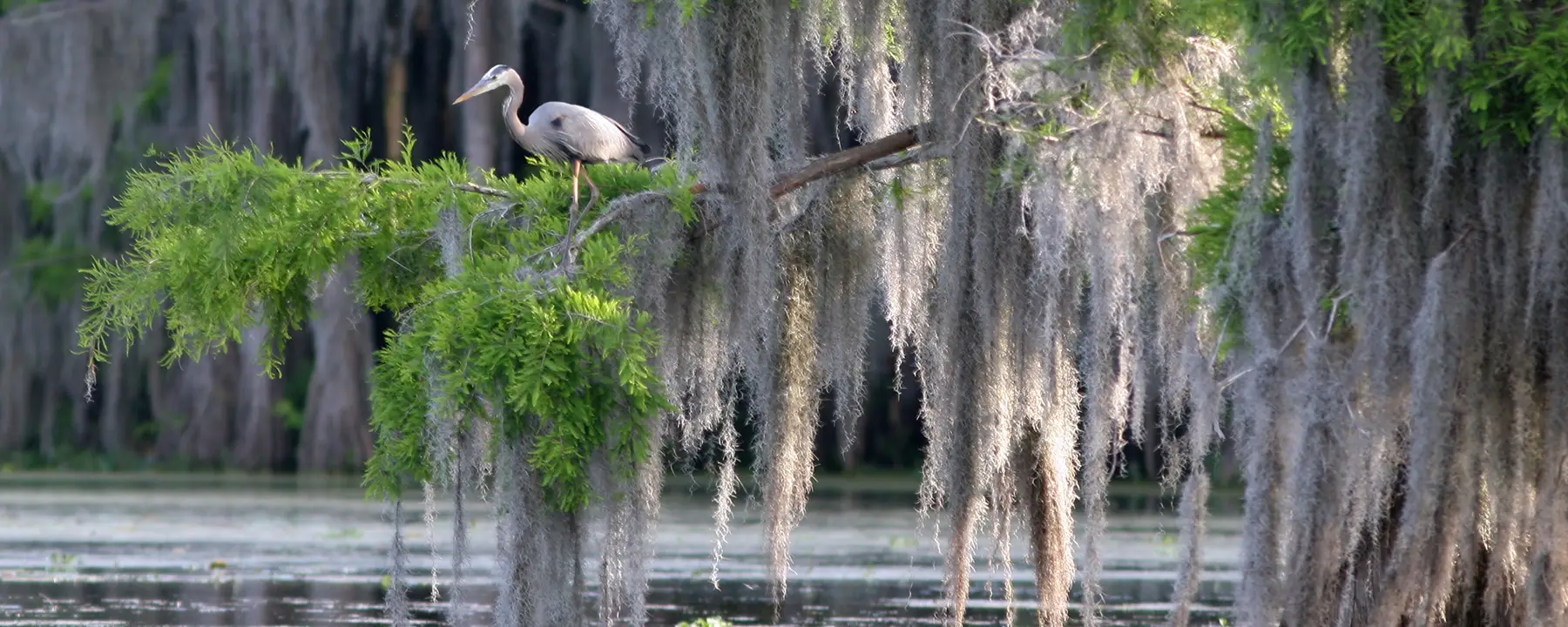Protecting Louisiana’s freshwater resources through more informed decision making
Louisiana is a water state. With more than 125,000 miles of rivers, bayous, and streams and abundant annual rainfall (48 to 70 inches annually), water has been and will continue to be inextricably linked to the state’s economy, culture, and fish and wildlife resources.
While the water wealth of Louisiana is often taken for granted by citizens and decision makers, evidence is beginning to suggest that continued abundance of fresh water in the state may not be a foregone conclusion.
Future decisions regarding freshwater resources will affect citizens, economic development, fish and wildlife, agricultural production, and coastal resources. For instance, in some areas of Louisiana, increased residential and industrial development have been linked to declines in aquifer levels and changes in water quality, and these changes have direct effects on future drinking water supply. Additionally, the desire by other states to acquire fresh water from Louisiana results in economic and political questions over allocation of water rights from the state’s rivers. These decisions will have direct effects on downstream salinity and, consequently, coastal resources in Louisiana.
These factors illustrate the need for sustainable water planning in Louisiana—to determine where Louisiana’s water is going to come from, who and what entities (including natural systems) are going to receive fresh water, and how much fresh water is going to cost.
These and other water-related questions demand quality scientific information on current status and trends of surface and groundwater resources, river and stream flow, water use, and threats to freshwater resources, as well as the linkage between and among freshwater and coastal systems.
The Louisiana Freshwater Assessment Charts a New Course
To aid in the conservation of freshwater resources, the Louisiana chapter of The Nature Conservancy is developing the Louisiana Freshwater Assessment, a scientifically sound evaluation of watershed health. This initiative will study landscape integrity, including land use and cover, floodplain connectivity, and channelization, as well as water quality and biological health for all 57 watersheds in the state. When completed, it will provide a robust scientific assessment and be displayed in an online mapping system, The Nature Conservancy’s Freshwater Network, which contains both decision support capability and access to all data sets.
Ultimately, the Louisiana Freshwater Assessment is intended to draw attention to the status of Louisiana’s freshwater resources and provide a powerful and user-friendly tool for decision makers, environmental resource managers, local watershed conservation groups, and the general public to facilitate the development of freshwater science and conservation strategies, prioritize freshwater conservation, and evaluate the effects of current and future water use and watershed development proposals.
Applying RTI’s WaterFALL® Modeling System to Assess Louisiana Watersheds
RTI is working with The Nature Conservancy to conduct watershed modeling and develop applications within the Freshwater Network to display and analyze modeled streamflow data through Louisiana and Mississippi. We applied our Watershed Flow and Allocation model (WaterFALL) to develop 30-year daily time-step scenarios of streamflow across the enhanced National Hydrography Dataset (NHDPlus) stream network within these two states.
WaterFALL is a rainfall-runoff model that simulates surface runoff and baseflow stream contributions on a daily basis using land use, soils, and climate characterizations at the NHDPlus scale.
For this project, we began by completing a pilot phase assessment on three watersheds within Louisiana—the Sabine, Ouachita, and Pearl. We then expanded the modeling effort to full watershed areas within Louisiana and Mississippi, quantifying surface water withdrawals and discharges due to industry, public water supply, agriculture, and energy production.
The model was calibrated to U.S. Geologic Survey streamflow gages when available to ensure that WaterFALL sufficiently represented observed streamflow conditions. The output of the model included daily streamflows at more than 100,000 locations corresponding to NHDPlus catchments within Louisiana and Mississippi.
To manage the vast amount of data developed from the modeling effort, RTI and The Nature Conservancy determined a set list of hydrologic flow metrics to provide a summary characterization of the hydrologic regime. These metrics have been shown to be useful in determining the ecological condition within a stream.
Customizing Web Applications to Meet Targeted Needs
Working with The Nature Conservancy to design applications that meet their needs and the needs of the target audience of the Freshwater Network, we have developed two web applications that use the statewide WaterFALL data.
Hydro Flows App for Quantifying Hydrologic Flow Metrics
The Hydro Flows App delivers the hydrologic flow metrics and displays streamflow conditions over time for each 12-digit hydrologic unit (HUC12) through a series of graphs and tables within the two states. This application also allows a user to select a HUC12 or catchment of interest through the mapping interface and quantify the hydrologic flow metrics at the state level using graduated coloring. The user can also determine the upstream drainage area or the downstream flow path from a selected point of interest.
Oyster Flows App for Predicting Salinity Concentrations
The Oyster Flows App uses statistical relationships between modeled streamflows from WaterFALL and observed lake salinity concentrations. It predicts the likelihood that salinity concentrations within a lake will be outside the optimal monthly range of salinity for oyster health given changes in streamflow driven by human uses.
Two lakes are currently included within the Oyster Flows App: Sabine Lake, which may see streamflow changes due to modifications of water uses within the upstream Toledo Bend Reservoir, and Calcasieu Lake, which is just downstream of the City of Lake Charles with heavy water use by industry.
The application of WaterFALL and the subsequent analyses provide the data and framework for surface water management across use sectors and changing conditions within the state of Louisiana. We are pursuing further work to link our assessments with groundwater and coastal modeling to fully inform the water budget and legislative water code for the state.
- The Nature Conservancy
- Louisiana Chapter

